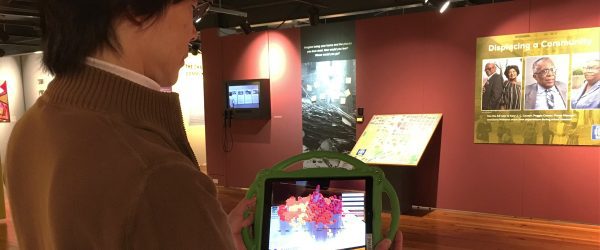Professor’s augmented reality project brings Levine Museum exhibit to life

Associate Professor of Urban Design Ming-Chun Lee has collaborated with the Levine Museum of the New South to integrate augmented reality (AR) technology and GIS mapping into an exhibition about Charlotte neighborhoods, past and present.
“#Home CLT” explores the vast changes in five local neighborhoods, and in its most recent addition, presents the history of Brooklyn, an uptown African-American neighborhood destroyed by 1960s urban renewal.
With the help of two graduate students in the College of Computing and Informatics, Lee developed AR technology that allows users to view, via an app, dynamic virtual social and economic data across a set of large maps created by students in Lee’s GIS/Urban Mapping class. The same app also activates videos of Charlotteans talking about their neighborhoods, oral histories that bring narrative power to the visual data.
“The key idea behind ‘#Home CLT’ is storytelling,” said Lee. “You have different ways to tell a story—graphics, audio, video—but we also identified a storytelling by the numbers—through data.”
In the Levine’s exhibition, data leap off of the huge floor maps in colorful bars and columns that appear on the screen of an iPad that visitors receive upon entering the museum. Information about home values, population density, and residents’ income, educational attainment, and race and ethnicity becomes three-dimensional and can be tracked over time with the swipe of a finger. (Read more about the exhibition in the Charlotte Observer.)
“In the GIS community, there has been a movement from 2D to 3D maps,” Lee said. “That’s the big idea behind these efforts. We live in a 3D world. The 2D map was created for convenience—you can fold your map and put it in your pocket. Creating 3D maps is actually a natural process, and is also more convincing. When you put two sets of data together, such as income and home values, you can clearly see the correlations.”
Lee and the Levine Museum began their partnership in spring 2018, with the encouragement and support of the Knight Foundation, which named Lee a Niantic/Knight Fellow in August 2018. The current exhibition is not the end of their collaboration, and their next project is to create a walking tour that incorporates AR and perhaps virtual reality (VR) technology so that participants can actually “see” the streets of Brooklyn as they used to be.
“We want to bring the exhibit from inside to outside,” said Lee. “The idea is to break the wall.”
While enabling people to more fully experience the past, Lee is also developing partnerships with city departments, such as transportation, to explore ways to use technology to envision the future.
“We’re creating new tools so that we can do urban design and planning in a better way. We can communicate with people more efficiently. We want to make informed decisions and show the potential implications, impacts of those decisions,” Lee stated. “I’ve just touched the surface.”